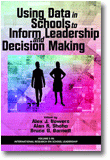
Using Data in Schools to Inform Leadership and Decision Making
Edited by:
Alex J. Bowers, Teachers College, Columbia University
Alan R. Shoho, University of Texas at San Antonio
Bruce G. Barnett, University of Texas at San Antonio
A volume in the series: International Research on School Leadership. Editor(s): David Gurr, University of Melbourne, Australia. Elizabeth T. Murakami, University of North Texas.
Published 2014
Our fifth book in the International Research on School Leadership series focuses on the use of data in schools and districts as useful information for leadership and decision making. Schools are awash in data and information, from test scores, to grades, to discipline reports, and attendance as just a short list of student information sources, while additional streams of data feed into schools and districts from teachers and parents as well as local, regional and national policy levels. To deal with the data, schools have implemented a variety of data practices, from data rooms, to data days, data walks, and data protocols. However, despite the flood of data, successful school leaders are leveraging an analysis of their school’s data as a means to bring about continuous improvement in an effort to improve instruction for all students.
Nevertheless, some drown, some swim, while others find success. Our goal in this book volume is to bring together a set of chapters by authors who examine successful data use as it relates to leadership and school improvement. In particular, the chapters in this volume consider important issues in this domain, including:
• How educational leaders use data to inform their practice.
• What types of data and data analysis are most useful to successful school leaders.
• To what extent are data driven and data informed practices helping school leaders positively change instructional practice?
• In what ways does good data collection and analysis feed into successful continuous improvement and holistic systems thinking?
• How have school leadership practices changed as more data and data analysis techniques have become available?
• What are the major obstacles facing school leaders when using data for decision making and how do they overcome them?
CONTENTS
Considering the Use of Data by School Leaders for Decision Making: An Introduction, Alex J. Bowers, Alan R. Shoho and Bruce G. Barnett. PART 1: LEADERSHIP DATA PRACTICES IN SCHOOLS. Charter Principal Autonomy: A Missed Connection between Data-Driven Decision-Making and Instructional Leadership, Dana L. Bickmore. Schools’ Use of Interim Data: Practices in Classrooms, Teams, and Schools, Elizabeth Nash Farley-Ripple and Joan L. Buttram. Strengthening Collaborative Data Practices in Schools: The Need to Cultivate Development Perspectives and Diagnostic Approaches, Shelby Cosner. PART 2: SOURCES OF EVIDENCE USE IN SCHOOLS FOR TEACHERS, PRINCIPALS AND SUPERINTENDENTS. Longitudinal Data Use: Ideas for District, Building, and Classroom Leaders, Kay Brocato, Chris Willis, and Kristen Dechert. Which Data Do Principals and Teachers Use to Inform Their Practice? Evidence From Germany With a Focus on the Infl uence of School Culture, Denise Demski. Measuring School Capacity for Continuous Improvement, Elizabeth Leisy Stosich. PART 3: THE IMPACT OF EVIDENCE USE POLICIES IN SCHOOLS AND DISTRICTS. Principals’ and Teachers’ Perceptions of Teacher Evaluation and their Implications in Arab Schools in Israel, Khalid Arar. Making Progress with Growth Models in Education: Utility for School Improvement, Jennifer Koran and Cameron Carlson. Depth of Use: How District Decision-makers Did and Did Not Engage with Evidence, Elizabeth Nash Farley-Ripple and Vincent Cho. PART 4: CONCLUSIONS AND FUTURE TRENDS. Data-Driven Leadership for Learning in the Age of Accountability: Afterword: Using Data in Schools to Inform Leadership and Decision Making, Rich Halverson. About the Contributors.
-
Paperback9781623967864
Web price: $45.04 (Reg. 52.99)
-
Hardcover9781623967871
Web price: $80.74 (Reg. 94.99)
- eBook9781623967888

-
 Challenges and Opportunities of Educational Leadership Research and Practice
The State of the Field and Its Multiple Futures
Challenges and Opportunities of Educational Leadership Research and Practice
The State of the Field and Its Multiple Futures
-
 Educational Leadership for Social Justice and Improving High-Needs Schools
Findings from 10 Years of International Collaboration
Educational Leadership for Social Justice and Improving High-Needs Schools
Findings from 10 Years of International Collaboration
-
 Educational Leadership, Culture, and Success in High-Need Schools
Educational Leadership, Culture, and Success in High-Need Schools
-
 Examining the Assistant Principalship
New Puzzles and Perennial Challenges for the 21st Century
Examining the Assistant Principalship
New Puzzles and Perennial Challenges for the 21st Century
-
 School and District Leadership in an Era of Accountability
School and District Leadership in an Era of Accountability
-
 School Principals in Mexico
Cases of Leadership Success
School Principals in Mexico
Cases of Leadership Success
-
 The Changing Nature of Instructional Leadership in the 21st Century
The Changing Nature of Instructional Leadership in the 21st Century

